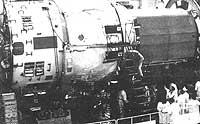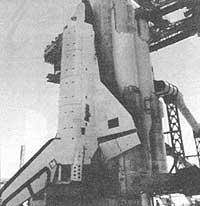The longest stay
1988/04/01 Oilarra, A. Iturria: Elhuyar aldizkaria
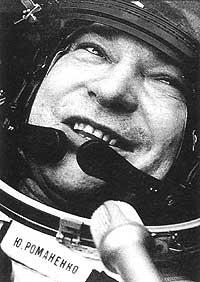
If we analyze Soviet policy in the exploration of space, we discover the importance of the long stays of the cosmonauts. Long-lasting Soviet flights began in 1977. Romanenko and Gretxko performed 96 days in space. The following year Kovaleno and Iventxenkov were 140 days. Then in 1979 Liakov and Riumin 175 days. From then on, the implementation of the new records slowed. In 1980 Popov and Riumine spent 184 days in space; in 1982 Berezevoi and Lebedev marked 211 days and in 1984 Kizim, Soloviev and Atkov in 237 days. Finally, Romanenko has spent almost a year (326 days) in space.
As can be thought, this continuous record breach is more than a brand new and is framed within a general policy. In addition to this long-term policy, a central axis is followed which is divided into two: To the preparation of a manned mission that will be postponed on Mars at the beginning of the next century and, in passing, to analyze the psychological and physiological problems that generate the long stays in space.
Road to Mars
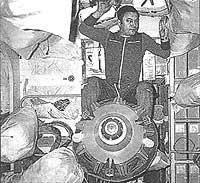
The exploration of the planets of our system has been an eternal dream of spatial mentality. Among all planets, Martitz is undoubtedly the most attractive and affordable. The automatic probes sent by man have already studied, from space and from the surface, the red planet. Although we have deepened their knowledge, this deepening has increased appetite and the man-led mission is considered essential by scientists. There are many outstanding questions about Martitz and his nature and evolution, among which is his own life. In addition, for many Martitz would be the best place to build the first human colonies in space.
The journey to Mars is long. It would take about three hundred days to go, about two months to perform the explorations and return enough time to go. With Romanenko's journey, the Soviets simulate the Lurra-Martitz journey. To simulate it all would be enough for a time to return to space once past. A similar experience is already in the years 1979-80 with Riumin. Riumin made 175 space days in 1979 with Liakov. In 1980 he was sent to space after several months on Earth, where he spent 184 days with Popov again.
Physiological and psychological problems
As mentioned above, the expedition to Mars requires a long time in the weightless environment. As is known, in this environment the human body suffers damage and dysfunctions. In addition, prolonged permanence in a narrow and closed place generates psychological problems.
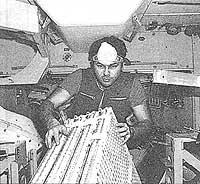
With Romanenko, Soviet scientists have had the opportunity to carry out exhaustive studies and, in addition, have been able to demonstrate their models on the problems generated by long flights.
Romanenko, of course, has faced physiological and psychological problems. He has suffered a great pain (especially in recent months), has felt the need for his family and has been losing desire to work. For this reason, they had to lower their day from 8 to 5.50 hours daily.
From the physiological point of view, Romanenko has lost 15% of its muscle mass, but only 1% of its muscle fibers. You have followed a high-calorie diet: 4 000 calories distributed in four meals and 1.6 kg weight. His organism has suffered great changes. However, you can recover from these changes.
Soviet scientists are very pleased with the results of the sessions. On the one hand, the health status of Romanenko has been maintained as they themselves had foreseen. On the other hand, the Soviets have shown that their models of adaptation to the effects of long-lasting flights are useful.
Flight of Romanenko
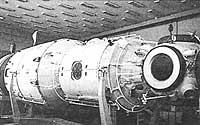
Romanenko and his friend Laveikin were thrown on February 5, 1987 to the Mir space station. The initial idea was that the two cosmonauts were together, but in some studies carried out in July small inadequacies were detected in the electrocardiogram of Laveiki and the Soviet doctors decided to return to Earth. In the space of Laveikin, after 173 days, he landed on Earth. Alexandrov has been Romanenko's new friend during the 160 days of flight. It's not bad brands like Laveiki and Alexandrov!
On December 21, 1987, the feast of St.Thomas, the cosmonauts Titov, Manarov and Levtxenko embarked on Soyuz TM-4 as a relay to Mir station. Titov and Manarov stayed in Mirea and the pilot Levtxenko brought them to Romanenko and Alexandrov on December 29. It is said that Titov and Manarov Romanenko, who have stayed in the Mir space station, are thinking about breaking the placed mark and their goal is to be around 400 days.
Mars seems closer than ever.

Gai honi buruzko eduki gehiago
Elhuyarrek garatutako teknologia




